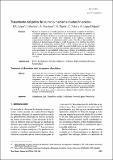Por favor, use este identificador para citar o enlazar a este item:
http://hdl.handle.net/10261/21263COMPARTIR / EXPORTAR:
 SHARE SHARE
 CORE
BASE CORE
BASE
|
|
| Visualizar otros formatos: MARC | Dublin Core | RDF | ORE | MODS | METS | DIDL | DATACITE | |

| Título: | Tratamiento del polvo de aluminio mediante disolución acuosa |
Otros títulos: | Treatment of aluminium dust by aqueous dissolution | Autor: | López Gómez, Félix Antonio CSIC ORCID CVN ; Medina, J. A.; Tayibi, Hanan CSIC; Peña, Carmen; López-Delgado, Aurora CSIC ORCID | Palabras clave: | Polvo de aluminio Residuo peligroso Hidrólisis Espectrometría de masas Reactividad Aluminium dust Hazardous residue Hydrolysis Evolved gases Reactivity |
Fecha de publicación: | 30-oct-2004 | Editor: | Consejo Superior de Investigaciones Científicas (España) | Citación: | Revista de Metalurgia 40(5): 389-394 (2004) | Resumen: | [ES] El polvo de aluminio es un residuo generado en la metalurgia secundaria del aluminio y
considerado peligroso como consecuencia de su elevada reactividad en presencia de
humedad. Con objetivo de buscar un procedimiento de pretratamiento de dicho residuo, de
acuerdo con la Directiva Europea sobre vertederos, se ha realizado el estudio del
comportamiento del polvo de aluminio en medio acuoso. Para ello, se han analizado la
influencia de la temperatura, el tiempo y el pH de reacción en su hidrólisis. Los sólidos
hidrolizados se caracterizaron mediante EAA y DRX, mientras que en las soluciones
acuosas resultantes se determinaron el pH y la conductividad iónica. Los gases liberados
durante el proceso de hidrólisis se analizaron mediante espectrometría de masas. Asimismo,
se ha determinado la reactividad del residuo antes y después de la hidrólisis, analizando
amoniaco, sulfuro de hidrógeno y aluminio metálico. La hidrólisis, a 60 °C y después de
48 h, permite obtener material de muy baja reactividad que podría ser almacenado en
vertedero. [EN] Aluminium dust from aluminium remelting industry is a hazardous residue because of its high reactivity in the presence of water. In order to apply the new European Directive about landfill of waste, a study of its hydrolysis was carried out. The influence of temperature, time and pH on the hydrolysis of the aluminium dust was studied. The hydrolysed solids were characterized by XRD and AAS; in the aqueous solutions the pH and the ionic conductivity were determined. The evolved gases were analysed by mass spectrometry. The reactivity of the dust, before and after hydrolysis, was investigated by analysing the ammonia, hydrogen sulphide and metallic aluminium. By hydrolysis at 60 °C and 48 h a much lower reactive material was obtained which could be disposed with minimal environmental impact. |
Descripción: | 6 páginas, 2 figuras, 1 tabla. | Versión del editor: | http://dx.doi.org/10.3989/revmetalm.2004.v40.i5.294 | URI: | http://hdl.handle.net/10261/21263 | DOI: | 10.3989/revmetalm.2004.v40.i5.294 | ISSN: | 0034-8570 | E-ISSN: | 1988-4222 |
| Aparece en las colecciones: | (CENIM) Artículos |
Ficheros en este ítem:
| Fichero | Descripción | Tamaño | Formato | |
|---|---|---|---|---|
| 294-303-1-PB.pdf | 250,91 kB | Adobe PDF |  Visualizar/Abrir |
CORE Recommender
SCOPUSTM
Citations
3
checked on 31-mar-2024
WEB OF SCIENCETM
Citations
3
checked on 26-feb-2024
Page view(s)
375
checked on 22-abr-2024
Download(s)
2.532
checked on 22-abr-2024
Google ScholarTM
Check
Altmetric
Altmetric
NOTA: Los ítems de Digital.CSIC están protegidos por copyright, con todos los derechos reservados, a menos que se indique lo contrario.
